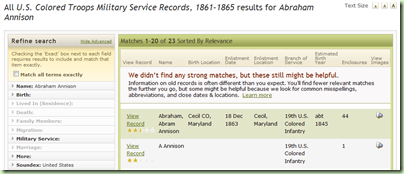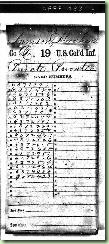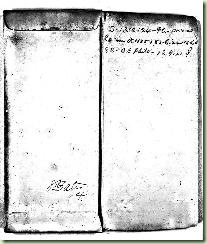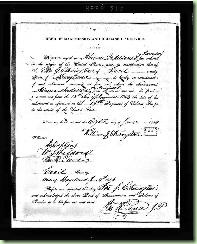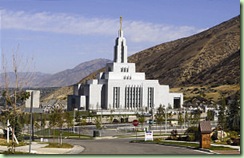The unofficial, unauthorized view of Ancestry.com and FamilySearch.org. The Ancestry Insider reports on, defends, and constructively criticizes these two websites and associated topics. The author attempts to fairly and evenly support both.
Tuesday, December 23, 2008
Contest images fixed
The Perfect "Search" Storm
 I've been meaning to do a search "shootout" for a long time, pitting Ancestry's old, exact search against Ancestry's new search experience. Mind you, I'm talking the whole ball of wax here, including Ancestry's tree-based search experience. Well, last night I found the "perfect storm," the optimum combination of elements to create a contest worthy of pitting the two titans against one another.
I've been meaning to do a search "shootout" for a long time, pitting Ancestry's old, exact search against Ancestry's new search experience. Mind you, I'm talking the whole ball of wax here, including Ancestry's tree-based search experience. Well, last night I found the "perfect storm," the optimum combination of elements to create a contest worthy of pitting the two titans against one another.
Anne? Are you listening? I've thrown down your gauntlet.
Any of you, all of you, can participate. The more the better. Do you feel like Ancestry.com's new search is a step backwards?
The rules of the contest are simple.
- Log in and set the search to old or new before you begin. Set or clear exact. Jot down your choices.
- Start from the home page. Record the time. GO!
- Start searching (or tree building), writing down a list of each keystroke and mouse click along the way.
- Score 100 points for each instance you find where the target individual is referenced by name in the U.S. Federal Census. Record the time, the number of keystrokes and mouse clicks, the census year and location. Then start a new count of keystrokes and mouse clicks.
OK. Maybe the rules need to be a little more explicit.
- For this shootout, each click of the mouse and tap of the keyboard counts one point. Don't forget to count scrolling, Back button and Forward button. Shift keys are free. Don't use your mouse's scroll wheel, since that neutralizes some differences between the formats of old and new search results. If you hover over a result link to see the pop-up information, count that as a click.
- Plan your strategy carefully in advance and record your experience the first time through. No fair going back and starting over using what you've learned. Be honest and include the clicks and taps from everything you try on your first time through, even activity that got you nowhere. See the last rule in this list for information about submitting subsequent or amended attempts.
- Be sure to include any clicks and taps after the last successful search up to the time that you stop searching. I know; it will be tempting to leave some of this off, deciding belatedly that you really stopped seriously looking several minutes earlier. "To thine own self be true..."
- If you plan to use Ancestry's tree-based searching, before you begin create a new tree with just yourself to preclude any pre-loaded, relevant information.
- Do not make any name corrections on Ancestry.com's records; that would alter the contest search experience for those that follow you. (Yes, you can read a hint into this rule.)
- Do not consult any information other than what is returned by Ancestry.com (other than the death certificate, as directed below).
- Do not look at the comments attached to this message.
- When you have results, post them as comments to this message. Your entry should include a list like this:
12:45, Start, Old search, Not exact, Tree-based
1:08, keys=452, clicks=72, 1900, California, Los Angeles, Los Angeles, p. 4
1:08, keys=0, clicks=0, 1920, California, Orange, Anaheim, p. 7
1:09, keys=0, clicks=1, 1910, California, Los Angeles, Los Angeles, p. 8
1:12, keys=138, clicks=15, 1880, Illinois, Cook, Chicago, p. 26
2:00, keys=351, clicks=186, stop
- The deadline for the contest is the end of day
Tuesday, 6 January 2009NEW: Friday, 9 January 2009. Because of the holidays, it is unlikely that Ancestry will change their website code during that time. That hopefully keeps all contestants on an equal footing. - If you wish to post your results on a blog of your own, may I ask that you post a comment here with a link to your results.
- Now the final rule. If you want to submit a subsequent or amended attempt, go ahead iff (that's short for "if and only if") you have first submitted an honest first attempt. Identify the submission as a later attempt and explain why other readers should consider it instead of or in addition to your first attempt. ("I misunderstood the instructions..." "This is the theoretical best for this search type..." "The sun was in my eyes..." "I don't know why I didn't follow my usual method..." "I wanted to try the other search...")
Have fun! And may the best search win!
 Oh... I almost forgot to set the stage.
Oh... I almost forgot to set the stage.
Family tradition says that you are cousins to the famous Ewings of Dallas, Texas! On her deathbed, your grand-aunt gives you an old photograph of your Ewing ancestor's headstone with a cemetery name penciled on the front. Click on the photograph, above, to see a full-sized copy. Then use FamilySearch Record Search pilot to find the death certificate. The John Ewing of the headstone and death certificate is the target of your Ancestry.com search. Everybody play fair. And don't forget to come back and post your results in a comment.
On your mark; get set; GO!
Monday, December 15, 2008
New FamilySearch
Remember, I am not a spokesperson for either Ancestry.com or FamilySearch International. This article gives my opinion as to the history, current state, and future of New FamilySearch. I have not included any confidential information and I am solely responsible for the contents of this article.
Dear Ancestry Insider,
I have a question and didn't want to look as uninformed as I really am by posting online. I ask for your patience, please. I've not been deeply involved with genealogy for about 6 years, but just got asked to teach a class in church at BYU, so I am frantically trying to get back up to speed.
I thought that there were temple districts using NFS as a beta test. Sacramento is one that I know for sure is. Aren't there several districts already using NFS in an effort to get all the kinks worked out? I read your announcement about Las Vegas and began to wonder. How will their use be different from the temple districts that are just testing it? And what are the implications for the rest of us?
Signed,
Ollie Magneson
Dear Ollie,
Don't worry; I wouldn't think of disclosing your uninformed-state secret. (Hold it, everyone! Before you send me nasty messages telling me I'm a discredit to my employer, I changed Mark's name... Oh, dang...)
Seriously, here's the skinny. New FamilySearch (NFS) is a single family tree that all of us share and work on in common, as if we all shared one PAF file. FamilySearch is temporarily calling it New FamilySearch and it is temporarily located at http://new.familysearch.org. But eventually it will be called FamilySearch Family Tree and will be relocated to www.familysearch.org. The 1.0 version will be available to all, members of the Church and non-members alike.
However, the first priority for NFS was to stop the flood of duplicate temple ordinances by replacing TempleReady and the associated need to check the International Genealogical Index (IGI) to avoid duplication. Accordingly, a version 0.9 was written to this end. It lacks many niceties considered standard in a genealogy product, but those features are not central to replacing TempleReady and can wait for a 1.0 product.
After alpha and beta testing were complete, a multiple-phase rollout was commenced on 26 June 2007 when St. Louis started using NFS. From that moment on, NFS has not been in some extended beta test as some suppose, but has been in real use in real temples.
Early users of NFS found bugs, of course, as well as user interface problems. That is one reason for doing a phased release. But these problems were nothing, in retrospect. Like the hero of a tragedy, NFS 0.9 contained an unknown fatal flaw that doomed it to failure as soon as the rollout began. Ironically, the flaw arises out of the problem that NFS is designed to avoid: too much duplication.
Our hero's tragic flaw
Somewhere along the line, two conflicting mantras were established for NFS. Our hero's fatal flaw results from an unforeseen interaction between the two.
- No one can change your data except you.
- To keep things simple, New FamilySearch combines Ancestral File, Pedigree Resource File and the International Genealogy Index into one database.
Not knowing the number of duplicates beforehand, the first mantra was kept by keeping a full copy of every piece of data, no matter how often duplicated. After the rollout began, users began combining duplicates from these three databases. Some individuals were duplicated many, many more times than expected and when NFS users combined them, "individuals of unusual size" (IOUS) started to grow.
Steps were taken to slow IOUS growth. The addition of PRF disks was halted. The import of complete GEDCOMs was frowned upon. And NFS continued to perform its primary function, adequately replacing TempleReady.
The Arizona
Then on 5 February 2008 the rollout hit Arizona. Because of the large number of Church members there who are descended from early Church members, the growth rate of IOUSes exploded and IOUSes became large enough to swamp the computer servers running NFS. The system was sometimes too slow to use. I'm sure within a week FamilySearch knew they had big problems. The decision to freeze would have been gut wrenching and probably had to reach to the highest levels. On the 19th, word first leaked out. On the 21st, official word was sent out. The rollout was stopped, frozen solid.
Emergency steps were taken to rehabilitate system performance. Hard limits were placed on the number of duplicates that can be combined. (I believe it is currently 85?) GEDCOM import size was restricted. I imagine the length of the delay was predicated on how long it took database engineers to scan through all the millions of individuals in NFS to find and split the IOUSes into pieces small enough for the system to handle.This had to be done while the system was in operation, actively serving 26 temples.
The result was an NFS that worked near flawlessly as a TempleReady replacement for anyone who doesn't have ancestors that were famous or were members of the Church. These ancestors were the ones becoming IOUSes. When the freeze thawed, the rollout could continue only in districts where most members didn't have many ancestors fitting this characterization. By 14 October the tragedy had run its course. Utah, Idaho and Las Vegas have been on hold ever since, waiting for a true fix to the IOUS problem. Rumors have pointed to Q3 or Q4 of next year before this newer than New FamilySearch will be ready.
Family Tree
While all this was going on, work on a 1.0 user interface was progressing. Developers are using a system called Agile Development that encourages regular user interaction during iterative development. This allows us, the future users of the program, to try things out along the way, identify design flaws and influence the product before it is set in stone. If you have a New FamilySearch account, you should feel a responsibility to do this at http://labs.familysearch.org.
That brings you up to the unexpected announcement that Vegas was going live without the rest of us! What does that mean? Obviously, FamilySearch feels like the system is robust enough to handle the additional traffic and that letting Las Vegas start using the system is worthwhile, despite members inability to combine all duplicates together.
Teaching Church Members in Utah
In the mean time, what do you teach in Utah?
- Teach the members the fundamentals of source-based research and analysis. It's the only way the quagmire of NFS will ever get cleaned up.
- Teach the members the extreme importance of avoiding further duplication. Each hour of necessary research now will save ten later on.
- Teach the members to follow the rules for temple submissions. Stop submitting people you're not related to. Stop submitting people you don't have nearest-kin permission for. Those that do so are embarrassing the Church and turning away the hearts of those we'd like to bless. You will be held responsible for those who might have accepted ordinances (alive or dead), but didn't because of your disobedience.
- Teach members the importance of turning their hearts in two directions. Those with Church-member ancestors should seek out their spiritual experiences, histories and photographs. Teach all members to never let their own spiritual experience go unrecorded, for their future posterity.
- Teach members not to feel guilty. We don't need everyone to do everything; we just hope everyone can do something. Do only what you have time to do. FamilySearch Indexing is great for students who only have 10 minutes here or there for family history. Just be sure to Save to Server, so your few minutes of work can be passed on to another to finish.
I hope this helps. Above all, have fun! This is a glorious work.
Sincerely,
The Ancestry Insider
Thursday, December 11, 2008
Visiting NARA: Civil War Soldiers & Sailors
I recently made my first visit to the National Archives and Record Administration (NARA). This is one in a series of articles inspired by that visit to help you make your first visit to the National Archives.
Civil War Soldiers and Sailors
The National Park Service is assembling an online index of American Civil War Soldiers and Sailors (CWSS) at
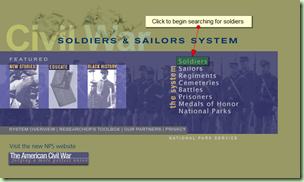 Sailors have yet to be completed, but soldiers were completed in September 2004. The index contains entries for 6.3 million soldiers, both Union and Confederate. The index was assembled by the park service and partners from index cards archived by NARA. Historians have determined that approximately 3.5 million soldiers actually fought in the War. A soldier serving in more than one regiment, serving under two names, or spelling variations resulted in the fact that there are 6.3 million General Index Cards for 3.5 million soldiers. (Source)
Sailors have yet to be completed, but soldiers were completed in September 2004. The index contains entries for 6.3 million soldiers, both Union and Confederate. The index was assembled by the park service and partners from index cards archived by NARA. Historians have determined that approximately 3.5 million soldiers actually fought in the War. A soldier serving in more than one regiment, serving under two names, or spelling variations resulted in the fact that there are 6.3 million General Index Cards for 3.5 million soldiers. (Source)
To begin searching for soldiers, click on Soldiers.
Putting it all together
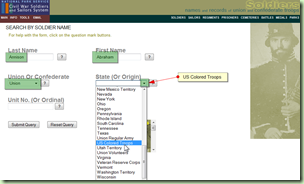 As an example of using the CWSS, let's see if we can find the compiled military service record (CMSR) of Abraham Annison, an African American from Maryland who fought for the Union. While we don't know in which unit Annison served, as an African American he would have been assigned to one of the US Colored Troop (USCT) regiments. Enter this information and click Submit Query.
As an example of using the CWSS, let's see if we can find the compiled military service record (CMSR) of Abraham Annison, an African American from Maryland who fought for the Union. While we don't know in which unit Annison served, as an African American he would have been assigned to one of the US Colored Troop (USCT) regiments. Enter this information and click Submit Query.
The one search result shows Abraham Annison of the 19th US Colored Infantry Regiment. Clicking on the regiment name, we see it was organized at Camp Stanton, Maryland. While it is common to find soldiers who signed up in states other than their own, finding an Annison in Maryland is enough to justify further investigation. The search results cite film number M589 roll 3 as the source of this information. I don't think any additional information is available, but we can look up m589 in the National Archive Research Catalog (ARC) to find the records M589 indexes. A search for M589 returns Indexes to the Carded Records... in which the "Function and Use" section indicates,
This series was created to index the series "Carded Records Showing Military Service of Soldiers Who Fought in Volunteer Organizations During the Civil War, 1890-1912" (ARC Identifier 300398).
A search for ARC identifier 300398 shows that the CMSRs for the USCT 19th are available on microfilm publication M1822. We are in luck! This regiment is one of the few for which compiled military service records are available on microfilm. Since it is available on microfilm, it is probably available online. We check the chart in my article titled "Compiled Military Service Records." In the row for "Union Army" and the column for "Online CMSRs" we see that CMSRs are available on Ancestry.com for a few USCT regiments.
On Ancestry.com, we search the database, "U.S. Colored Troops Military Service Records, 1861-1865" for Abraham Annison and find two potential matches. The first has 44 enclosures! Pay dirt!
Viewing the black and white images, we see the fire damaged CMSR envelope front and back.
Further into the documents we find some genealogically important information. From the "Company Descriptive Book" abstract card (left, below) we see that Annison was age 18 on 18 December 1863 and was born in Cecil County, Maryland. On the "Deed of manumission and Release of Service" (right, below) we see that Abraham Annison was also known as Abram Anderson, the slave of William G. Etherington of Cecil County, Maryland. Knowing the slave owner is necessary when researching Annison's ancestry. (It makes me ill to do African American genealogy; you research property records!)
Conclusion
That illustrates how to use the Civil War Soldiers and Sailors (CWSS) system. Most of the time you won't be lucky enough to find the CMSR online or on microfilm. You can order a copy of the CMSR from NARA for a fee. But you can also put it on your list of records to look at when you make your first visit to the National Archives in Washington, D.C.
Wednesday, December 10, 2008
Compiled Military Service Records
Compiled Military Service Records
When researching volunteers, start with the compiled military service records.
Some years after the Civil War, the War Department needed an efficient method of checking military and medical records in connection with claims for pensions and other benefits. Beginning in 1886 the staff of General Fred Crayton Ainsworth began the ambitious project of abstracting various military service records for volunteer soldiers: muster and pay rolls, descriptive rolls, returns, hospital records, prison records, accounts for subsistence and other materials. For each time an individual volunteer's name appeared in these records a card was prepared.

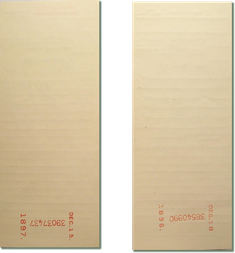
Front and reverse sides of the two cards in one soldier's service record.
A unique number is stamped on the reverse of each card.
The card abstracts for each individual soldier were placed into a jacket-envelope bearing the soldier's name, rank, and military unit. This jacket-envelope, containing one or more abstracts and, in some instances, including one or more original documents relating specifically to that soldier, is called a compiled military service record. (I've also seen various shortened forms of this long term such as military service record, compiled service record or simply CMSR.)
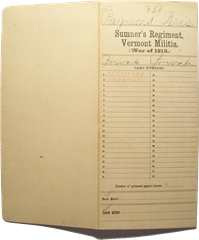
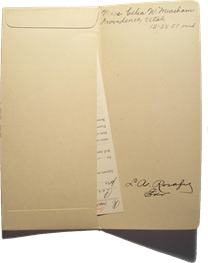
Front and reverse of a compiled military service record jacket-envelope,
shown in both views with the envelope flap open.
The number of each enclosed card is written on the front of the envelope.
A compiled military service record is only as lengthy as the material about an individual soldier and their unit. A typical record shows nothing but the soldier's name, rank, military unit, dates of entry into service and discharge or separation by desertion, death or dismissal. It may also show age, place of birth and residence at time of enlistment. If you are extremely lucky, for some wars it can include pension and benefit correspondence and documents between the soldier or his survivors and the war department. (For some wars, this material is held separately from CMSRs.) This type of material is the gold you are hoping to discover.
The cards were so carefully prepared that there is virtually no need to consult the original records from which they were made. The original records are thought to rarely contain additional information about particular soldiers.
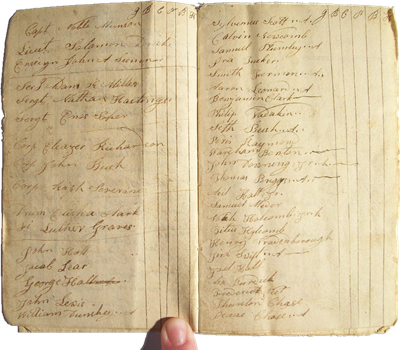
Original company records don't contain additional information about individuals.
(What idiot wasn't wearing cotton gloves?!? Me?!?)
Organization
Compiled military service records were arranged by war/historical period, thereunder by state or other designation, thereunder by military unit (usually regiment) and thereunder alphabetically by soldier surname. Microfilmed or computerized CMSRs typically maintain this organization.
While a historical period may bear the name of a war, records of other conflicts during the stated time period may be included. For example, War of 1812 includes years 1813-14 of the Creek Indian War. The wars and historical periods are:
| War or historical period | Years | Index on microfilm | Online Index | CMSRs on microfilm | Online CMSRs |
| The Revolutionary War | 1775-83 | M860 | Footnote | M881 | Ancestry, Footnote |
| Post-Revolutionary War period | 1784-1811 | M694 | N.A. | M905 | N.A. |
| War of 1812 | 1812-5 | M602 | Ancestry | M678* | N.A. |
| Indian wars | 1815-58 | M629, etc. | Ancestry | M1086* | N.A. |
| Mexican War | 1846-8 | M616 | N.A. | M278, M351, M638, M863, M1028, M1970 | N.A. |
| Union Army | 1861-5 | By state | CWSS | N.A.* | Ancestry* (USCT), Footnote* |
| Confederate Army | ditto | M253 | Ancestry, CWSS, Footnote† | By state | Ancestry* (CSA), Footnote† |
| Spanish-American War | 1898 | M871 | N.A. | M1087* | NARA (M1087) |
| Philippine Insurrection | 1898-1903 | M872 | N.A. | N.A. | N.A. |
N.A. = Not available
* A few are available
† Most are available
Finding aids
Various indexes exist to facilitate finding compiled military service records. Before computers were available, two types of card indexes were prepared for most of these records: general (nation-wide) and state indexes. These card indexes are available on microfilm and some have been computerized. New, computerized indexes exist for compiled military service records published online.
Consult an available index to learn if a CMSR exists for an ancestor and if so, the state and military unit or units (usually a regiment) in which he served. General indexes are available for every war or historical period, and state indexes exist for federal military units bearing a state name (for example, 1st Virginia Militia) except for the Mexican War and the Philippine Insurrection.
Each index card contains the soldier's name, rank, and military unit. General indexes include cross-references to variants of soldiers' names. Cross-references are made to the final unit designation if a unit was known by more than one name, and the various names are shown on one or more abstracts. In addition, cross-references are made to the appropriate unit designation if the records of the soldier's service in different units are consolidated into a single record.
Depending on the care taken in preparation and the search capabilities available, computerized indexes may or may not incorporate these cross-references. When searching online, be prepared to manually search for name variations and alternate unit names. For difficult to find ancestors, you may wish to consult all available indexes.
A researcher may fail to locate the record of an individual's volunteer military service for several reasons. The soldier may have served in the Regular Army (covered in Chapter 4 of Genealogical Research) or in a state unit that was not Federalized. His name may have been misspelled. (My ancestor Paul was denied a pension because he was indexed under Raul.) Proper records of his service may not have been made; or, if made, they may have been lost or destroyed in the confusion that often attended military operations. Or references to the soldier in the original records may be so vague that proper identification could not be made.
Sources for this article
Today's article is largely quoted (with liberal adaptations) from page 127 of Guide to Genealogical Research in the National Archives of the United States, chapter 5 ("Service Records of Volunteers"), section 5.1 ("Introduction"). Minor sources are
- "Fred Crayton Ainsworth, Major General, United States Army," Michael Robert Patterson, Arlington National Cemetery Website (www.arlingtoncemetery.net: Michael Robert Patterson, accessed 4 Dec 2008); this is a private, not a government website.
- "CWSS System Overview," National Park Service, Civil War Soldiers and Sailors System (www.civilwar.nps.gov: accessed 4 Dec 2008).
- National Archives Trust Fund Board, Military Service Records : a select catalog of National Archives microfilm publications (Washington, DC: National Archives Trust Fund Board, National Archives and Service Administration, 1985); equivalent catalog lists available online.
Tuesday, December 9, 2008
NFS Rollout update: NFS Version 0.95 released
Las Vegas rolls live 27 January
Dear Ancestry Insider,
OK! Here is the deal we have been waiting for...
Las Vegas will go live 27 January! And it should not be retracted this time!
The Las Vegas Temple has been equipped with the hardware since February 2008 and they are approved to use it!
What can I say more?
NFS Classic Version 0.95
New FamilySearch (NFS) Classic Version 0.95 was released over the weekend. It contains all the features I reported from the beta product.
There was one feature not quite ready then; now we can all see it. There is a new link on the home page labeled, "Click here for free, trial, and other products for new FamilySearch." The link goes to a page for FamilySearch Certified Affiliates, which are "third-party companies and organizations that provide products and services with features that are compatible with FamilySearch programs. Certification indicates the affiliate’s declaration of compliance with FamilySearch requirements. Note that these products and services are independently developed and supported by their respective organizations, not by FamilySearch."
The page currently contains special 60-day free trial offers from two Certified PAF Add-Ins, Ancestral Quest and FamilyInsight (formerly PAF Insight). Ancestral Quest is available for $29.95 and FamilyInsight for $25.00.
The page also contains an up to date table of all certified products and services.
The official list of recent changes can be seen in its entirety on the web.
FamilySearch Family Tree
A new version of FamilySearch Family Tree has been released: 0.21. According to the FamilySearch Labs blog, version 0.21 has these additional features:
- Easily move records out of a folder if the records don't belong to that person. Move the records to a new person folder or to an existing person's folder.
- Combine two folders when all the records belong to the same person.
- Expand and collapse display of family tree branches.
- Print family group records.
According to Gary Turner,
One other feature change I noticed was that in the Temple tab where it lists reserved names for the Temple they now show parents and spouses and seem to be loading somewhat sorted by families. It also seemed that it only loaded the page you were looking at, and if you want to see more of the list you needed to scroll down and wait for those names to load. I did notice a slight increase in speed in loading large record files, but it was still quite slow.
Thanks for your feedback, Gary.
Maybe I'll track the releases and we can see if there is any pattern to the release schedule:
| Version | Build | Time |
| 0.20 | 11736 | Fri Oct 17 2008 04:48:48 PM |
| 0.21 | 13139 | Thu Nov 20 2008 01:34:59 PM |
Monday, December 8, 2008
Visiting NARA: Genealogical Research Section B
I recently made my first visit to the National Archives and Record Administration (NARA). This is one in a series of articles inspired by that visit to help you make your first visit to the National Archives.
Genealogical Research, Section B
 For my example of using Guide to Genealogical Research in the National Archives of the United States, I'll look at Section B, "Military Records," chapters 4 and 5, "Records of the Regular Army" and "Service Records of Volunteers," respectively. The numbered subsections (and tables) of chapters 4 and 5 are
For my example of using Guide to Genealogical Research in the National Archives of the United States, I'll look at Section B, "Military Records," chapters 4 and 5, "Records of the Regular Army" and "Service Records of Volunteers," respectively. The numbered subsections (and tables) of chapters 4 and 5 are
CHAPTER 4 Records of the Regular Army
4.1 Introductions
4.2 Records Relating to Officers and Enlisted Men
4.3 Records of Officers
Table 5 Microfilm Publications of Regular Army Returns
4.4 Records of Enlisted Men
CHAPTER 5 Service Records of Volunteers
5.1 Introduction: Compiled Military Service Records
5.2 Volunteer Service Records by War
5.2.1 Revolutionary War
Table 6 Selected Genealogical Research Aids: Revolutionary War
5.2.2 Post-Revolutionary War Period
5.2.3 War of 1812
5.2.4 Indian Wars
Table 7 Selected Genealogical Search Aids: War of 1812
5.2.5 Mexican War
Table 8 Microfilmed Indexes to Compiled Military Service Records of Volunteers During the Indian Wars
5.2.6 Civil War—Union
Table 9 Microfilmed Indexes and Compiled Military Service Records for Union Army Volunteers
Table 10 Selected Genealogical Research Aids: Civil War—Union
5.2.7 Civil War—Confederate
Table 11 Microfilmed Indexes and Compiled Military Service Records for Confederate Army Volunteers
Table 12 Selected Genealogical Research Aids: Civil War—Confederate
5.2.8 Spanish-American War
5.2.9 Philippine Insurrection
Table 13 Selected Genealogical Research Aids: Spanish-American War and Philippine Insurrection
5.3 Records of Military Service in the 20th Century
5.3.1 World War I: Draft Records
5.3.2 World War II: Draft Records
5.3.3 Other Records
An online alternative to these chapters is Military Service Records at the National Archives, Reference Information Paper (RIP) 109. In either case, an excellent ancillary resource is "An Overview of Records at the National Archives Relating to Military Service," by Trevor K. Plante, Prologue Magazine.
Historically, most soldiers in our wars were volunteers. As you search for your ancestors, don't be surprised to find the size of the regular army to be small compared to the total number of combatants. So if you fail to find an ancestor in records of the regular army, be sure to check volunteer units and state militia (forerunners of today's National Guard).
Friday, December 5, 2008
Visiting NARA: Guide to Genealogical Research
I recently made my first visit to the National Archives and Record Administration (NARA). This is one in a series of articles inspired by that visit to help you make your first visit to the National Archives.
Genealogical Research
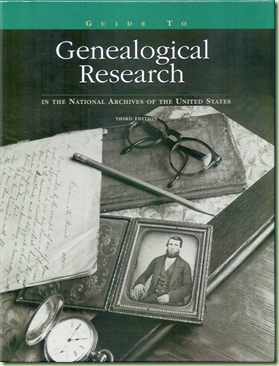 I mentioned in a previous article that using the Guide to Genealogical Research in the National Archives of the United States, third edition, is one of the best ways to prepare for a trip to the National Archives and Records Administration (NARA). It's a great guide to NARA records, even when accessing records online or on microfilm. I think I even volunteered to review the contents of the book and give examples of using it. So, here we go...
I mentioned in a previous article that using the Guide to Genealogical Research in the National Archives of the United States, third edition, is one of the best ways to prepare for a trip to the National Archives and Records Administration (NARA). It's a great guide to NARA records, even when accessing records online or on microfilm. I think I even volunteered to review the contents of the book and give examples of using it. So, here we go...
Book Contents
The table of contents of Genealogical Research gives a nice overview of the record types most likely to contain genealogically relevant material. The sections and chapters are:
INTRODUCTION 1
SECTION A Population and Immigration
Chapter 1 Census Records 13
Chapter 2 Passenger Arrivals and Border Crossings 49
Chapter 3 Naturalization Records 85SECTION B Military Records
Chapter 4 Records of the Regular Army 109
Chapter 5 Service Records of Volunteers 125
Chapter 6 Naval and Marine Service Records 153
Chapter 7 Pension Records 167
Chapter 8 Bounty Land Warrant Records 179
Chapter 9 Other Records Related to Military Service 189SECTION C Records Relating to Particular Groups
Chapter 10 Records of Civilians During Wartime 199
Chapter 11 Records of Native Americans 211
Chapter 12 Records of African Americans 237
Chapter 13 Records of Merchant Seaman 257
Chapter 14 Records of Civilian Government Employees 269SECTION D Other Useful Records
Chapter 15 Land Records 285
Chapter 16 Claims Records 305
Chapter 17 Records of the District of Columbia 317
Chapter 18 Miscellaneous Records 327
Chapter 19 Cartographic Records 339APPENDIX 1 List of Record Groups Cited 351
APPENDIX 2 List of Microform Publications Cited 353
Knowing the topics mentioned in the table of contents, if you don't have access to Genealogical Research, you can use online publications that cover these topics. Or search the NARA website using the search box in the upper-right corner.
Introduction
The Introduction Section contains basic information to make you more productive and prevent you from wasting time looking for records that NARA doesn't have.
Section I.1 talks about the "value and limitations of Federal records." NARA records are for Federal records only. For example, vital records are kept at the local or state level, so NARA doesn't have them. And it has no colonial era records. NARA's primary mission is to serve federal agencies, so to find an ancestor in NARA records, you need to think about how an ancestor would have interacted with the federal government.
In section I.3, "Record Organization," we read that records are arranged as best served the creating agency, not the genealogist. That's why this book and other finding aids are necessary. NARA records are organized by record groups (RGs) by creating agency. Record groups are divided into series. And series are divided into items.
Section I.5 is titled, "NARA Microform Publications." NARA publishes records in two microforms: microfilm and microfiche. Their publication program "has been assisted by the generous sharing of film produced by other groups, such as the Genealogical Society of Utah [FamilySearch, International]." Many NARA microform publications are available in the research rooms at their regional archives. Some of these can be purchased by individuals. Microform publications are cited in Genealogical Research and other finding aids by number and title. A typical citation is M694, Index to Compiled Service Records of Volunteer Soldiers Who Served from 1784 to 1811, 9 rolls.
The first letter of the microfilm number divides the publications into five categories.
| M | Most M publications cover an entire series. | NARA |
| A | These publications are numbered in the same sequence [as in the original records?]. They do not always reproduce a complete series, but may contain segments by date or subject. | May be copies produced by other Federal agencies. |
| T | ||
| P | Preservation purposes. | |
| C | Contractors produced but NARA can use after 7 yrs. |
Next time I'll provide usage examples from Section B, Military Records.
Thursday, December 4, 2008
NFS Rollout update: Las Vegas Temple to roll live
 R.B. in Las Vegas wrote Wednesday morning to say,
R.B. in Las Vegas wrote Wednesday morning to say,
While getting ready for the day today my Blackberry seemed a little busier then normal gathering the morning email. So imagine my delight when the email below was included in my inbox. Thank you for your blog and updates on New Family Search [NFS].
R.B.
Thanks, R.B! That's exciting news! Here's the email attached to R.B.'s message.
Date: Wednesday, December 3, 2008 4:57 AM
From: support@familysearch.org
To: en_LasVegasNevada
Message contains attachments:
06628_000_English_May08.pdf (200KB), 00727_000_English_FHCNSLT_Aug05.pdf (250KB)To: Family History Consultants
This email is to notify you that in about four months, the temple district in which you live will begin using new FamilySearch as part of the process for preparing ancestral names for the temple. TempleReady will no longer be used for this process. You should be able to register in new FamilySearch immediately upon receipt of this email. The Web address for the new FamilySearch is http://new.familysearch.org.
The attached information packet will assist you in your preparations to help members use this new process once the temple begins accepting the new Family Ordinance Request forms in lieu of TempleReady disks. You will also be receiving a hard copy of the packet by mail. Center directors will receive theirs directly from the Family and Church History Department. The copy for family history consultants will be sent to their bishop in their normal weekly priesthood mailing. An informational DVD will accompany the copy sent by mail. Copies of the rollout packet and the DVD may also be found on the Training and Resources page in the Help Center within the new FamilySearch.
Important note: You must have the Adobe Reader installed on your computer to view the attachments. It may be downloaded for free at www.adobe.com. To install the Adobe Reader, click on the Get Adobe Reader button on the Adobe Web site home page and follow the instructions.
We will send you a follow-up email approximately two weeks before the temple goes live with this process announcing the actual date.
If you have any questions, please contact FamilySearch Support.
Sincerely,
FamilySearch Support
support@familysearch.org
U.S. and Canada : 1-866-406-1830
International: Go to http://contact.familysearch.org for more toll-free phone numbers.
What is this, the third time you've been scheduled to go live? Will the third time be the charm? Do you think you'll go the full four months? That would be some time around early April. Or are you going to be another Montana? What did you guys get, two or three weeks? That would be some time around... well... Christmas!
New FamilySearch Classic Version 0.95
I reported last time that version 0.95 of NFS was in beta. The beta website has gone away, which typically means that 0.95 should be released very soon. FamilySearch Family Tree, meanwhile, is still on version... Hang on, let me check...
FamilySearch Family Tree is currently "Version: 0.20 Build: 11736 Time: Fri Oct 17 2008 04:48:48 PM". Everything I may or may not know about the schedule is via work. I've not heard any public comments or rumors on Family Tree's future, so I have nothing to pass on. I hate that. :-)
So...
Was Las Vegas the only district to receive word? Come on, Idaho! Anybody up there hearing anything? You know where to find me. AncestryInsider@gmail.com
Wednesday, December 3, 2008
Phish Bait
Off topic warning: This topic is not about genealogy, but may still be of interest to those who wish to learn more about Internet scams.
Phishing is the criminal act of "fishing for information," tricking people into revealing important information such as logins, social security numbers, bank accounts, etc. The Ancestry Insider recently received a phishing e-mail. This one was completely obvious... if you know what to look for.
As you go through the five numbered items below, look at each successive dark-green box in the image below.
- The e-mail didn't come from Capital One, but accounts.com.
- The "to" field of the e-mail is blank. That is a sign that the e-mail is SPAM, sent to dozens, even thousands of e-mail addresses.
- The e-mail doesn't identify me by name. Phishers can easily buy e-mail addresses harvested from the Internet, but they rarely have both e-mail address and name.
- I don't have a Capital One credit card, not in my own name and e-mail address and especially not in the name and e-mail of the Ancestry Insider! But when phishers SPAM enough e-mail addresses, even though they will send it to a lot of people that don't own the bait, they'll get a lot that do (be it a credit card, a bank account or a password with e-Bay, PayPal, etc.).
- NEVER, NEVER click a link in a suspicious e-mail, particularly to get to your bank or any other website that requires a password, credit card number or other important information. Always go directly to the home page of the website by typing in the address of the website. In this example, I could go to www.capitalone.com, login and see if I get the same important notice contained in the suspicious e-mail. I won't, though. These phishers didn't bother to disguise the link—which can be done. The link begins with http://210.90.121.50 instead of http://www.capitalone.com. When http:// is followed by four numbers instead of an Internet address, don't trust it!
 Anti-Phishing Phil is an online game from Carnegie Mellon University that can help you learn how to recognize dangerous links and Internet addresses such as the one with the four numbers in the phishing e-mail I received. It will teach you not to take phishing bait; and it's free for personal use.
Anti-Phishing Phil is an online game from Carnegie Mellon University that can help you learn how to recognize dangerous links and Internet addresses such as the one with the four numbers in the phishing e-mail I received. It will teach you not to take phishing bait; and it's free for personal use.
Deceptive Pop-ups
Last month Dick Eastman wrote about another scam: deceptive pop-ups. Eastman learned the hard way that you NEVER click anywhere inside an unwanted pop-up. Here's an example:
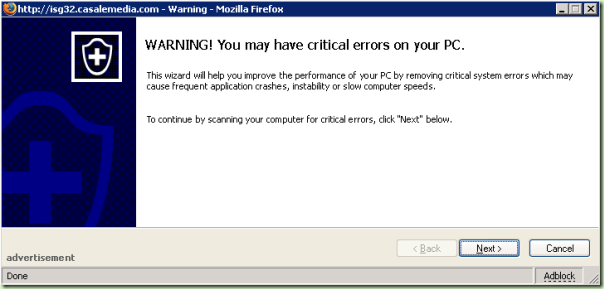
Image credit: Derek Quenneville
To do its dastardly work, this pop-up needs you to click. But since it is from a dastardly company, the click doesn't have to be on Next. As Dick found out, Cancel works just as well. All they need is a click, anywhere inside the window frame.
Always close the window using the X in the upper-right corner. At least that's what I've always done and have never had any problems. If you wish to be doubly safe, I recently read a suggestion that closing the window via the task bar at the bottom of your screen is even safer.
Tuesday, December 2, 2008
Church News: Joseph B. Wirthlin, Oldest Apostle, Dies, Age 91
 I just learned of this news release from lds.org:
I just learned of this news release from lds.org:
Elder Wirthlin had gone to bed at his Salt Lake City home, and died peacefully at about 11:30 pm of causes incident to age. His oldest daughter, Jane Wirthlin Parker, was present. A member of the family had been staying and caring for Elder Wirthlin, whose wife, Elisa Young Rogers Wirthlin, died in 2006.
He had continued to work at his office right up until the Thanksgiving holiday.
Funeral arrangements will be announced.
Table of Contents: Visiting NARA
I recently made my first visit to the National Archives and Record Administration (NARA). I've written a series of articles designed to help you make your first visit and to open up the records of the National Archives for your use. This article is the table of contents, as it were, for that series.
I didn't write the articles in the logical sequence shown below, so you can't use the "Newer Post" and "Older Post" links at the bottom of each article to move through the recommended sequence. Return here to click the link to the next article.
Preparative research
- The Archives website
- NARA Publications
- Guide to Genealogical Research in the National Archives
- "Section B, Military Records," Genealogical Research
- Compiled Military Service Records (CMSRs)
- Civil War Soldiers and Sailors
- Colored sheet finding aids
Records online or on microfilm
- NARA Records in your home town: Archives.gov, Ancestry.com, FHL/FHC
- NARA records on Footnote.com as of November 2008
- Other NARA records online: HeritageQuest online, FamilySearch.org (pilot)
Lodging, transportation and meals
- Staging a visit to Archives I - Airport, motel and metro
- Maps and restaurant reviews for the Greenbelt/College Park area
Your time at Archives I
- Archives I and Archives II
- Hours and security, equipment receipt and lockers
- The exhibits and the cafeteria
- Research Card
- Pulling Records
- Finding your way around (coming slowly, if at all)
- Making reproductions
Monday, December 1, 2008
Visit FHL + tour temple interior
We interrupt our regularly scheduled series about visiting the National Archives to make an important announcement. If you're planning a visit to the Family History Library (FHL) in Salt Lake City in the next several months, an opportunity is available that you shouldn't miss. The Church of Jesus Christ of Latter-day Saints has announced an open house and public tours of the Draper Utah Temple. The open house will extend from 15 January 2009 until 14 March 2009.
Unlike chapels of the Church, temples are normally closed to all but worthy members of the Church. The completion of a new temple provides a rare opportunity for the general public to view the interior of these buildings, each revered by Church members as the House of the Lord. The Draper Utah Temple will be just the 129th operating temple of the Church worldwide.
Open house tours are free but require tickets, and convenient times may be scooped up quickly. Tickets may be obtained starting Monday, 1 December 2008 at 10:00 AM MST by contacting 1-800-537-6181 (toll-free), 1-801-240-7932 (toll) or online at www.lds.org/reservations.
If you're planning on visiting the FHL during the open house, call right away to get your tickets. I don't know if the FHL will provide a shuttle between the library and the new temple for visitors who are not members of the Church. I'll suggest it to Don Anderson. But, first worry about getting tickets and if this is your first tour inside a temple, I'll drive you myself if I have to. I think it's that important of an opportunity to see the other half of the Church's family history equation. The Draper Utah Temple is a 23 mile drive south of the FHL and Google estimates a drive time of 33 minutes.
There is no preaching, no sermon and no pressure. In fact, talking inside the Temple is discouraged. Individuals walk through the temple in a long, continuous line. Wheelchairs are typically accommodated. No guide will accompany you and there is no audio tour. Prior to entering the Temple a short video (8 to 15 minutes?) introduces basic information about the Temple and its place in Church doctrine. Placards placed throughout the building identify the names or purposes of rooms as you walk through the building. While Church volunteers are present throughout the building, they provide crowd control and maintain reverence. Questions should be held until after exiting. Like I say, no pressure.
And in my opinion, a definite "not to be missed."
We now rejoin our Visiting NARA series, already in progress...
Wednesday, November 26, 2008
Visiting NARA: Other records online
I recently made my first visit to the National Archives and Record Administration (NARA). This is one in a series of articles inspired by that visit to help you make your first visit to the National Archives.
HeritageQuest Online

Like Footnote.com and FamilySearch.org, HeritageQuest also lacks a comprehensive list of NARA publications available. However, HeritageQuest is the only one among these sites that provides the ability to take a NARA census citation and bring up the corresponding census image.
Four of the six HeritageQuest search categories contain NARA records. I've included the NARA publication numbers for three of those.
- "Search Census" contains a complete set of U.S. Federal Census images for the population schedules from 1790-1930, but a limited set of name indexes. NARA publication numbers are M637 (1790), M32 (1800), M252 (1810), M33 (1820), M19 (1830), M704 (1840), M432 (1850), M653 (1860), M593 and T132 (1870), T9 (1880), M407 (1890), T623 (1900), T624 (1910), T625 (1920), and T626 (1930). To aid in understanding the census, HeritageQuest includes The Census Book: A Genealogists Guide to Federal Census Facts, Schedules and Indexes by William Dollarhide, HeritageQuest, 2001.
- "Search Revolutionary War" contains "selected records from the Revolutionary War Era Pension & Bounty-Land Warrant Application Files" (NARA publication M805) which contains some of the records from the full set. The full set (NARA publication M804) is available on Footnote.com which I covered previously.
- "Search Freedman's Bank" contains records from Freedman's Bank from 1865-1874. The NARA title is "Registers of Signatures of Depositors in Branches of the Freedman's Savings and Trust Company, 1865 - 1874." and the publication number is M816.
- "Search U.S. Serial Set" contains records from memorials, petitions, and private relief actions of the U.S. Congress. HeritageQuest describes the collection as containing both the United States Congressional Serial Set, (1817-1969) and its predecessor, the American State Papers (1789-[1816?]). The Congressional Serial Set, described here, is huge, containing over 14,000 printed volumes, doubtlessly containing copies of hundreds of thousands of congressional documents held by NARA. If your pre-visit or onsite NARA research uncovers a record for which the ARC catalog notes that some of the records were published in the "Congressional Serial Set," then use this HeritageQuest collection.
FamilySearch Record Search Pilot
The FamilySearch Record Search pilot is still too young to expect proper support for NARA citations or for finding aids for NARA records. Hopefully, product managers will incorporate these important features in the future. Because of the pre-beta state of this product, I won't bother to compile a finding aid for you at this time.
Tuesday, November 25, 2008
Ancestry.com map feature lost
On November 13th Ancestry.com announced a new mapping feature for their Member Trees. The announcement, originally at http://blogs.ancestry.com/ancestry/2008/11/13/see-the-people-in-your-tree-on-a-map read in part,
See the people in your tree on a map
By Kenny Freestone on Uncategorized
Ancestry.com now helps you visualize where important events occurred in the lives of your ancestors by placing their events on a map.
How to use it
We’ve updated the family tree so that just about anywhere we show a place, you can click on that place and see the link on the map. ... In addition to viewing the important places in your family members’ lives, you can also find places to help you in your research efforts. We have links to show local cemeteries and courthouses, and “Other Places” link displays a list of additional display options where you can find historical information—churches, historical sites, libraries and archives, and government buildings.
Then Wednesday afternoon website performance started to suffer. Messages started showing up online asking about the problem. By late afternoon, Ancestry.com was dead. I'm not certain how long it was down, but it was back up by evening. This "signature" is consistent will rolling a change to the website that destabilized operations. Did something new roll live? Was it fixed or did Ancestry.com "roll-back" the changes?
Queries to company spokespersons about the cause of the crash went unanswered. Then the announcement, above, went away. I looked around for the map feature and was not able to find it, so either the feature went away or I was looking for it in the wrong place.
Now the announcement is back, but this time it includes a bold warning that the software is in beta form. And several known bugs are noted. If you have feedback on this new feature or any other member tree problem, Kenny Freestone is in listening mode. Leave a comment on the announcement or send email to (kfreestone at tgn.com). If you don't want Kenny to see your complaint, attach your comment to this article.
Monday, November 24, 2008
Visiting NARA: NARA records on Footnote.com
I recently made my first visit to the National Archives and Record Administration (NARA). This is one in a series of articles inspired by that visit to help you make your first visit to the National Archives.
NARA records on Footnote.com as of November 2008
Footnote is second only to Ancestry.com in the number of NARA publications available on its website. And unlike Ancestry.com, all Footnote.com content is available for free to patrons (that includes you) at a Family History Center near your home.
On the other hand, unlike Ancestry.com, Footnote.com doesn't provide a way to assist the researcher to find a publication using the NARA publication number or the NARA title. Hopefully this is an inadequacy Footnote.com can soon fix.
For the present time, the good folks at Footnote.com provided me a current list of NARA records available on Footnote.com. I'm not certain if the titles shown are the NARA publication titles or the Footnote.com titles. Also, no indication is provided as to the number of NARA microfilm rolls currently included in the Footnote.com publication of the same, so there is no way to compare the roll count to the total number of rolls currently available from NARA.
In the list, below, I've created hyperlinks for each publication. Click on the NARA publication number to go to Footnote.com's online, digitized copy of that publication. The publications are sorted in publication order. Use your browser's find or search capability to quickly locate a publication number or search for a keyword in the title.
At the bottom of this article are six publications or collections without NARA microfilm publication numbers. Presumably, these are collections that Footnote has digitized directly, saving the time, expense and trouble of going to microfilm before going to digital. If that is the case, then these are records that previously were never visible outside the walls of the National Archives and Footnote.com deserves kudos for going beyond digitizing NARA microfilm.
| Pub # | Title |
| C72 | Navy JAG Case Files of Pacific Area War Crimes Trials, 1944-1949 |
| C73 | Army JAG Case Files of Pacific Area War Crimes Trials, 1944-1949 (Including Iwanami Case) |
| M40 | Domestic Letters of the Department of State, 1784-1906 |
| M61 | Foreign Letters of the Continental Congress and Department of State, 1785-1790 |
| M162 | The Revolutionary War Prize Cases: Records of the Court of Appeal in Cases of Capture, 1776-1787 |
| M246 | Revolutionary War Rolls, 1775-1783 |
| M247 | Papers of the Continental Congress |
| M251 | Compiled Service Records of Confederate Soldiers Who Served in Organizations from the State of Florida |
| M258 | Compiled Service Records of Confederate Soldiers Who Served in Organizations Raised Directly by the Confederate Government. |
| M266 | Compiled Service Records of Confederate Soldiers Who Served in Organizations from the State of Georgia |
| M267 | Compiled Service Records of Confederate Soldiers Who Served in Organizations from the State of South Carolina |
| M268 | Compiled Service Records of Confederate Soldiers Who Served in Organizations from the State of Tennessee |
| M269 | Compiled Service Records of Confederate Soldiers Who Served in Organizations from the State of Mississippi |
| M270 | Compiled Service Records of Confederate Soldiers Who Served in Organizations from the State of North Carolina |
| M276 | Compiled Service Records of Volunteer Union Soldiers Who Served in Organizations From the State of Alabama. |
| M311 | Compiled Service Records of Confederate Soldiers Who Served in Organizations from the State of Alabama |
| M318 | Compiled Service Records of Confederate Soldiers Who Served in Organizations From the Territory of Arizona. |
| M319 | Compiled Service Records of Confederate Soldiers Who Served in Organizations from the State of Kentucky |
| M320 | Compiled Service Records of Confederate Soldiers Who Served in Organizations from the State of Louisiana |
| M321 | Compiled Service Records of Confederate Soldiers Who Served in Organizations From the State of Maryland. |
| M322 | Compiled Service Records of Confederate Soldiers Who Served in Organizations from the State of Missouri |
| M323 | Compiled Service Records of Confederate Soldiers Who Served in Organizations from the State of Texas |
| M324 | Compiled Service Records of Confederate Soldiers Who Served in Organizations from the State of Virginia |
| M331 | Compiled Service Records of Confederate General and Staff Officers, and Nonregimental Enlisted Men |
| M332 | Miscellaneous Papers of the Continental Congress |
| M346 | Confederate Papers Relating to Citizens or Business Firms, 1861-65 |
| M367 | Records of the Department of State Relating to World War I and its Termination, 1914-1929 |
| M570 | Copybooks of George Washington's Correspondence with Secretaries of State, 1789-1796 |
| M599 | Investigation and Trial Papers Relating to the Assassination of President Lincoln |
| M653 | 1860 U.S. Federal Census - Population |
| M668 | Ratified Indian Treaties, 1722-1869 |
| M787 | Civil War IRS Records for State of Pennsylvania, 1862-66 |
| M804 | Revolutionary War Pension and Bounty-Land Warrant Application Files |
| M835 | Select List of Photographs of Harry S. Truman, 1885-1953 |
| M865 | Selected Photographs of Franklin D. Roosevelt, 1913-1945 |
| M866 | Records from the Constitutional Convention of 1787 |
| M867 | Selected Photographs of Calvin Coolidge, 1917-1943 |
| M868 | Selected Photographs of Dwight D. Eisenhower, 1943-1961 |
| M881 | Compiled Service Records of Soldiers Who Served in the American Army During the Revolutionary War |
| M923 | Records of the American Section of the Supreme War Council, 1917-19 |
| M924 | Historical Files of the U.S. Expeditionary Force, North Russia, 1918-19 |
| M928 | Prize and Related Records for the War of 1812 of the U.S. District Court for the Southern District of New York, 1812-16 |
| M930 | Cablegrams Exchanged Between General Headquarters, American Expeditionary Forces, and the War Department, 1917-19 |
| M990 | Gorrell's History of the American Expeditionary Forces Air Service, 1917-1919 |
| M995 | Papers and Minutes of Meetings of Principal World War II Allied Military Conferences, 1941-1945 |
| M1003 | Case Files of Applications from Former Confederates for Presidential Pardons ("Amnesty Papers"), 1865-67 |
| M1017 | Compiled Service Records of Former Confederate Soldiers who Served in the 1st Through 6th U.S. Volunteer Infantry Regiments, 1864-1866. |
| M1085 | Investigative Case Files of the Bureau of Investigation 1908-1922 |
| M1148 | General Photographs of the Fine Arts Commission (Series G), CA. 1650-1950 |
| M1164 | Index to the Naturalization Petitions of the United States District Court for the Eastern District of New York, 1865-1957 |
| M1164 | Index to the Naturalization Petitions of the United States District Court for the Eastern District of New York, 1906-Nov 1925 |
| M1164 | Index to the Naturalization Petitions of the United States District Court for the Eastern District of New York, Jul 1865-Sep 1906 |
| M1168 | Indexes to Naturalization Petitions to the U.S. Circuit and District Courts for Maryland, 1797-1951 |
| M1279 | Case Files of Approved Pension Applications of Widows and Other Dependents of Civil War and Later Navy Veterans (Navy Widows' Certificates), 1861-1910 |
| M1301 | Applications for Enrollment of the Commission to the Five Civilized Tribes, 1898-1914 |
| M1360 | Admiralty Final Record Books of the U.S. District Court for the Southern District of Florida (Key West), 1829-1911 |
| M1368 | Petitions and Records of Naturalizations of the U.S. District and Circuit Courts of the District of Massachusetts, 1906-1929 |
| M1372 | Passport Applications, 1795-1905 |
| M1380 | Missing Air Crew Reports (MACRs) of the U.S. Army Air Forces, 1941-1948 |
| M1401 | Territorial Case Files of the U.S. District Courts of Utah 1870-1896 |
| M1407 | Southern Claims Commission |
| M1442 | Records of the Department of State Relating to Internal Affairs of France, 1930-1939 |
| M1469 | Case Files of Approved Pension Applications of Civil War and Later Navy Veterans (Navy Survivors' Certificates), 1861-1910 |
| M1518 | Ratified Amendments XI-XXVII of the U. S. Constitution |
| M1522 | Naturalization Petitions for the Eastern District of Pennsylvania, 1795-1930 |
| M1524 | Naturalization Petitions for the Southern District Of California, 1887-1940 |
| M1526 | Naturalization Index Cards from the Superior Court of San Diego, CA, 1868-1958 |
| M1537 | Naturalization Petitions of the U.S. District Court, 1820-1930, and Circuit Court, 1820-1911, for the Western District of Pennsylvania |
| M1545 | Index to Petitions and Records of Naturalizations of the U.S. and District Courts for the District of Massachusetts, 1907-1966 |
| M1613 | Naturalization Records in the Superior Court of San Diego, CA, 1883-1958 |
| M1614 | Naturalization Records of the Superior Court of Los Angeles, CA, 1876-1915 |
| M1626 | Naturalization Petitions of the U.S. Circuit and District Courts for the Middle District of Pennsylvania, 1906-1930 |
| M1640 | Naturalization Petitions of the U.S. District Court for the District of Maryland, 1906-1930 |
| M1653 | U.S. Strategic Bombing Survey (Pacific): Japanese Air Target Analyses, Objective Folders, and Aerial Photographs, 1942-45 |
| M1674 | Soundex Index to Petitions for Naturalizations Filed in Federal, State, and Local Courts in New York City, 1792-1906 |
| M1675 | Alphabetical Index to Declarations of Intention of the U.S. District Court for the Southern District of New York, 1917-1950 |
| M1676 | Alphabetical Index to Petitions for Naturalization of the US District Court [and Circuit Court] for the Southern District of New York, 1824-1941 |
| M1677 | Alphabetical Index to Petitions for Naturalizations of the U.S. District Court for the Western District of New York, 1907-1966 |
| M1733 | Photographs of Japanese Soldiers and of Allied Prisoners of War, 1942-1945 |
| M1752 | U.S. Submarine War Patrol Reports, 1941-1945 |
| M1753 | Records Relating to the Various Cases Involving the Spanish Schooner AMISTAD, 1815-1858 |
| M1787 | Compiled Service Records of Volunteer Union Soldiers Who Served in Organizations from the Territory of Nebraska. |
| M1789 | Compiled Service Records of Volunteer Union Soldiers Who Served in Organizations from the Territory and State of Nevada. |
| M1816 | Compiled Service Records of Volunteer Union Soldiers Who Served in Organizations from the State of Oregon. |
| M1820 | Compiled Military Service Records of Volunteer Union Soldiers Who Served With the United States Colored Troops, 2nd through 7th Colored Infantry including 3d Tennessee Volunteers (African Descent), 6th Louisiana Infantry (African Descent), and 7th Louisiana Infantry (African Descent). |
| M1821 | Compiled Service Records of Volunteer Union Soldiers Who Served with the United States Colored Troops: Infantry Organizations, 8th through 13th, including the 11th (new). |
| M1879 | Petitions for Naturalization of the US District Court for the Eastern District of New York, 1865-1937 |
| M1899 | Court-Martial Case Files Relating to the "Hesse Crown Jewels Case", 1944-1952 |
| M1915 | Land Entry Case Files of the Broken Bow Land Office, Broken Bow, NE: Homestead Final Certificates, 1890-1908 |
| M1952 | Index to Naturalizations of World War I Soldiers, 1918 |
| M1972 | Petitions for Naturalization of the US District Court for the Southern District of New York, 1897-1944 |
| M1995 | Naturalization Petition and Record Books for the US District Court for the Northern District of Ohio, Eastern Division, Cleveland, 1907-1946 |
| M2012 | Appellate Case File No. 2161, United States v. The Amistad, 40 U.S. 518 (15 Peters 518), Decided March 9, 1841, and Related Lower Court and Department of Justice Records |
| P2012 | 13th Naval District Public Information Department Press Clippings, 1942-1960 |
| P2233 | Records of the U.S. Circuit Court for the Eastern District of Louisiana, New Orleans Division: Petitions, 1838-1861 |
| T252 | Mathew B Brady Collection of Civil War Photographs |
| T289 | Organization Index to Pension Files of Veterans Who Served Between 1861 and 1900. |
| T1103 | General Court Martial of Gen. George A. Custer, 1867 |
| T1196 | Selected Pension Application Files Relating to the Mormon Battalion, Mexican War, 1846-48 |
| T1206 | Project Blue Book, 1947-1969 |
| T1249 | Records of the Department of State Relating to Internal Affairs of the Soviet Union, 1930-1939 |
| Click here | Case Files of Approved Pension Applications of Widows and Other Dependents of Civil War Veterans, ca. 1861 - ca. 1910 |
| Click here | Pearl Harbor Muster Rolls |
| Click here | Southern Claims Commission Approved Claims, 1871-1880 |
| Click here | Black and White and Color Photographs of U.S. Air Force and Predecessor Agencies Activities, Facilities, and Personnel - World War II |
| Click here | Photographs of Marine Corps Activities in Vietnam, 1962-1975 (Color) |
